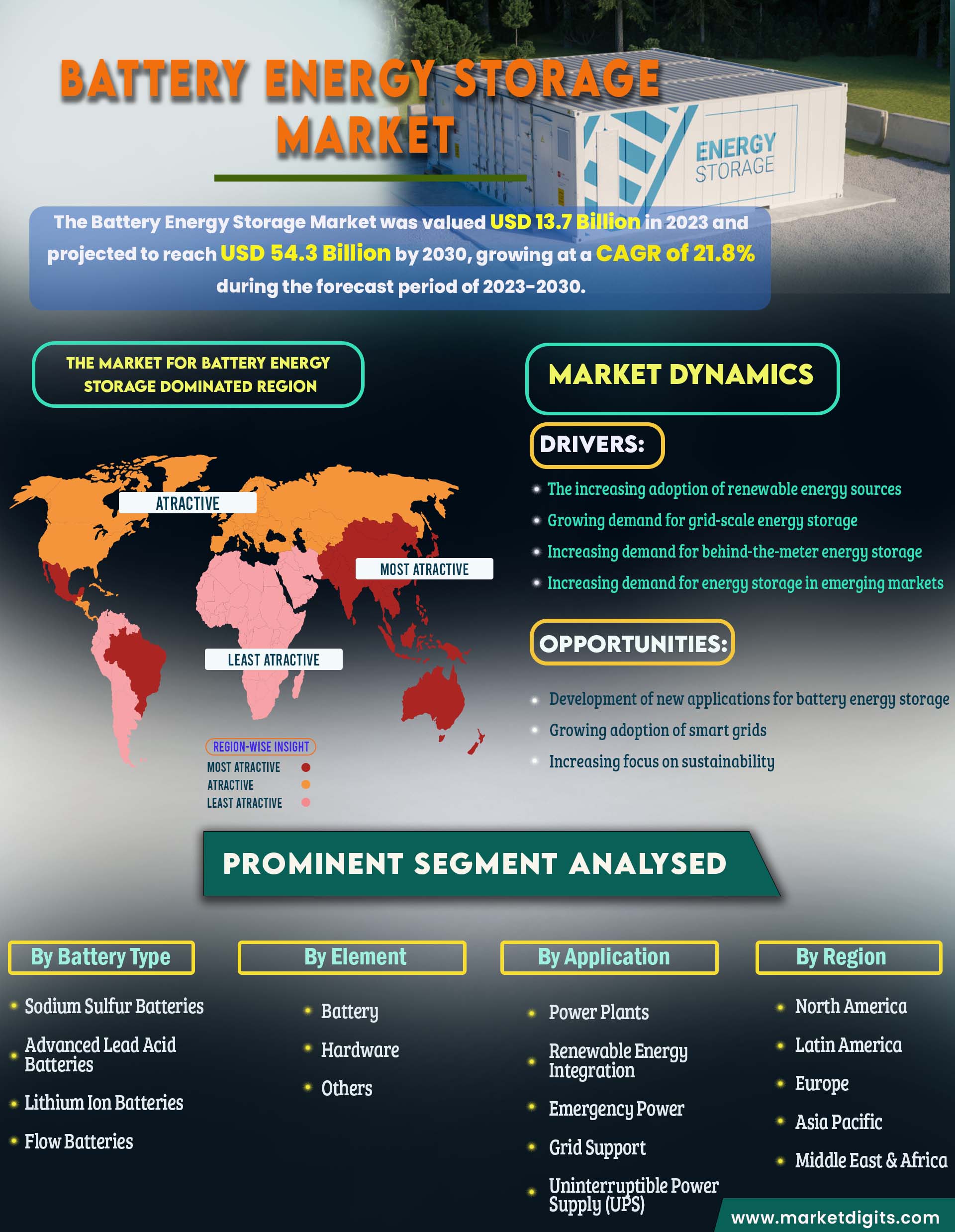- Home
- Energy & Power
-
Battery Energy Storage System Market

Battery Energy Storage Market by Battery Type, Element (Battery, Hardware and Others), Ownership, Connection Type, Application and Region Partner & Customer Ecosystem (Product Services, Proposition & Key Features) Competitive Index & Regional Footprints by MarketDigits - Forecast 2024-2032
Industry : Energy & Power | Pages : 180 Pages | Published On : Apr 2024
Market Overview
Battery energy storage involves the storage of electrical energy in rechargeable batteries for subsequent use. This process encompasses the utilization of rechargeable batteries to store surplus electricity generated from diverse sources, including renewable energy systems like solar and wind power, as well as electricity from the grid during periods of lower demand. The stored energy can be released during peak demand periods or when there is a shortfall in electricity supply. Battery energy storage systems (BESS) are pivotal in facilitating the integration of renewable energy sources into the electrical grid. The escalating demand for renewable energy, coupled with the imperative to address grid stability challenges, propels the adoption of BESS. These systems play a critical role in storing excess energy from renewable sources, providing a dependable and efficient solution for balancing power supply and demand. The market is witnessing notable progress in battery technologies, with lithium-ion batteries leading due to their high energy density, extended lifespan, and decreasing costs. However, emerging technologies like flow batteries and solid-state batteries are gaining recognition for their potential to offer greater energy storage capacities and enhanced safety features. Government initiatives and supportive policies promoting clean energy sources are fostering market growth. Numerous countries are setting ambitious renewable energy targets and implementing favorable regulations, including subsidies and incentives, to encourage the widespread adoption of battery energy storage systems.
Major vendors in the global Battery Energy Storage market: ABB, AEG Power Solution, Exergonix Inc., General Electric, Hitachi, LG Chem, Mitsubishi Heavy Industries Ltd., NEC Corporation, Panasonic Corporation, Samsung SDI Co. Ltd., Siemens AG, Tesla Inc., Toshiba Corporation and Others.
Rapid implementation of grid energy storage systems is a key aspect of ongoing projects focused on modernizing the grid.
Initiatives aimed at modernizing the grid often involve the integration of renewable energy sources such as solar and wind power. However, the intermittent nature of renewables can lead to power supply fluctuations. To address this challenge, battery energy storage systems play a crucial role by storing surplus energy during high generation periods and releasing it during peak demand or when renewable sources are inactive. This contributes to grid stabilization, ensuring a reliable power supply. These systems enable grid operators to store excess electricity, enhancing reliability and flexibility across the entire electricity supply chain, including generation, transmission, and distribution. Battery energy storage systems perform various functions during electricity transmission and distribution, including asset deferral, frequency regulation, harmonic suppression, voltage support, and maintenance of power quality. Additionally, these systems offer benefits such as electric energy time-shifting, baseload leveling, peak shaving, renewable energy time-shifting, and renewable capacity firming for grid-connected solutions.
Market Dynamics
Drivers:
- The increasing adoption of renewable energy sources
- Growing demand for grid-scale energy storage
- Increasing demand for behind-the-meter energy storage
- Increasing demand for energy storage in emerging markets
Opportunities:
- Development of new applications for battery energy storage
- Growing adoption of smart grids
- Increasing focus on sustainability
Development of new battery technologies
The Battery Energy Storage Market is witnessing significant advancements with the ongoing development of new battery technologies. The evolution of battery technologies is a key driver propelling the market forward. Innovations in materials, chemistry, and design are shaping the landscape, leading to batteries with improved performance, longer lifespan, and enhanced safety features. Lithium-ion batteries have traditionally dominated the market, yet emerging technologies such as solid-state batteries, flow batteries, and advanced energy storage materials are gaining prominence. Solid-state batteries, in particular, are garnering attention for their potential to provide higher energy density and safety benefits. The constant pursuit of more efficient and sustainable energy storage solutions is fostering a competitive environment, driving research and development efforts towards creating batteries that meet the evolving demands of various applications, from residential to industrial and grid-scale energy storage.
The market for Battery Energy Storage is led by Asia Pacific.
In 2022, the Asia-Pacific region has recorded the highest market value. The escalating carbon emissions have heightened the demand for renewable energy sources, consequently driving the battery energy storage market. Notably, countries like China and India stand out as major consumers of battery energy storage, with substantial investments in the renewable energy sector contributing to a rising number of installations. The presence of numerous manufacturers in the region has facilitated increased product supply. China, in particular, holds the position as the largest global market for battery energy storage, projected to command an estimated market share of 32.90% across the Asia-Pacific region by 2022. This dominance is attributed to the multitude of manufacturers in the country and substantial investments by relevant authorities, especially Public Service Safety Commissions. The implementation of stringent pollution control regulations is a pivotal factor attracting investments in the energy storage market.
On the other hand, North America is anticipated to experience significant growth, primarily driven by the widespread adoption of battery energy storage in the commercial and utility sectors. The region's active involvement in renewable energy projects is contributing to a robust growth rate. Regulatory bodies in North America are actively endorsing the use of battery energy storage across countries to establish standardized safety regulations. Among the North American nations, the USA stands out as the largest market shareholder in the battery energy storage market, with an estimated market share expected to be realized by the end of 2022. Anticipated market growth in the USA is attributed to industrial manufacturing regulations governing transmission and power generation, thereby fostering the adoption of battery energy storage solutions.
The Lithium-ion batteries Segment is Anticipated to Hold the Largest Market Share During the Forecast Period
The battery energy storage market is categorized based on battery type, including sodium sulfur batteries, advanced lead acid batteries, lithium ion batteries, flow batteries, and others. Lithium-ion batteries dominate the battery energy storage market, holding the largest share. This dominance can be attributed to their high energy density, enabling the storage of a substantial amount of energy in a compact and lightweight package. Additionally, lithium-ion batteries boast an extended cycle life compared to other battery technologies, enduring numerous charge-discharge cycles without significant performance degradation. Moreover, these batteries demonstrate remarkable efficiency, achieving a high energy conversion rate during charging and discharging processes. This efficiency results in minimized energy losses and enhanced overall system performance, establishing lithium-ion batteries as a cost-effective and reliable solution in the market.
Major Segmentations Are Distributed as follows:
- By Battery Type
- Sodium Sulfur Batteries
- Advanced Lead Acid Batteries
- Lithium Ion Batteries
- Flow Batteries
- Others
- By Element
- Battery
- Hardware
- Others
- By Ownership
- Utility Owned
- Customer Owned
- Third-party Owned
- By Connection Type
- On-Grid
- Off-Grid
- By Application
- Power Plants
- Renewable Energy Integration
- Emergency Power
- Grid Support
- Uninterruptible Power Supply (UPS)
- By Region
- North America
- US
- Canada
- Latin America
- Brazil
- Mexico
- Argentina
- Colombia
- Chile
- Peru
- Rest of Latin America
- Europe
- Germany
- France
- Italy
- Spain
- U.K.
- BENELUX
- CIS & Russia
- Nordics
- Austria
- Poland
- Rest of Europe
- Asia Pacific
- China
- Japan
- South Korea
- India
- Thailand
- Indonesia
- Malaysia
- Vietnam
- Australia & New Zealand
- Rest of Asia Pacific
- Middle East & Africa
- Saudi Arabia
- UAE
- South Africa
- Nigeria
- Egypt
- Israel
- Turkey
- Rest of MEA
- North America
Recent Developments
- In October 2023, Tesla, Inc., announced the launch of its new Megapack battery storage system in October 2023. The Megapack is a grid-scale battery storage system that can store up to 35 megawatt-hours of electricity. It is designed for use in large-scale energy storage applications, such as utility power plants and renewable energy projects.
- In September 2023, LG Energy Solution, a subsidiary of LG Chem, announced a partnership with General Motors to develop and supply battery packs for GM's electric vehicles. The partnership is expected to help GM to increase the production of its electric vehicles and compete more effectively with Tesla002E
Answers to Following Key Questions:
- What will be the Battery Energy Storage Market’s Trends & growth rate? What analysis has been done of the prices, sales, and volume of the top producers of Battery Energy Storage Market?
- What are the main forces behind worldwide Battery Energy Storage Market? Which companies dominate Battery Energy Storage Market?
- Which companies dominate Battery Energy Storage Market? Which business possibilities, dangers, and tactics did they embrace in the market?
- What are the global Battery Energy Storage industry's suppliers' opportunities and dangers in Battery Energy Storage Market?
- What is the Battery Energy Storage industry's regional sales, income, and pricing analysis? In the Battery Energy Storage Market, who are the distributors, traders, and resellers?
- What are the main geographic areas for various trades that are anticipated to have astounding expansion over the Battery Energy Storage Market?
- What are the main geographical areas for various industries that are anticipated to observe astounding expansion for Battery Energy Storage Market?
- What are the dominant revenue-generating regions for Battery Energy Storage Market, as well as regional growth trends?
- By the end of the forecast period, what will the market size and growth rate be?
- What are the main Battery Energy Storage Market trends that are influencing the market's expansion?
- Which key product categories dominate Battery Energy Storage Market? What is Battery Energy Storage Market’s main applications?
- In the coming years, which Battery Energy Storage Market technology will dominate the market?
Reason to purchase this Battery Energy Storage Market Report:
- Determine prospective investment areas based on a detailed trend analysis of the global Battery Energy Storage Market over the next years.
- Gain an in-depth understanding of the underlying factors driving demand for different Battery Energy Storage Market segments in the top spending countries across the world and identify the opportunities each offers.
- Strengthen your understanding of the market in terms of demand drivers, industry trends, and the latest technological developments, among others.
- Identify the major channels that are driving the global Battery Energy Storage Market, providing a clear picture of future opportunities that can be tapped, resulting in revenue expansion.
- Channelize resources by focusing on the ongoing programs that are being undertaken by the different countries within the global Battery Energy Storage Market.
- Make correct business decisions based on a thorough analysis of the total competitive landscape of the sector with detailed profiles of the top Battery Energy Storage Market providers worldwide, including information about their products, alliances, recent contract wins, and financial analysis wherever available.
TOC
Table and Figures
Methodology:
At MarketDigits, we take immense pride in our 360° Research Methodology, which serves as the cornerstone of our research process. It represents a rigorous and comprehensive approach that goes beyond traditional methods to provide a holistic understanding of industry dynamics.
This methodology is built upon the integration of all seven research methodologies developed by MarketDigits, a renowned global research and consulting firm. By leveraging the collective strength of these methodologies, we are able to deliver a 360° view of the challenges, trends, and issues impacting your industry.
The first step of our 360° Research Methodology™ involves conducting extensive primary research, which involves gathering first-hand information through interviews, surveys, and interactions with industry experts, key stakeholders, and market participants. This approach enables us to gather valuable insights and perspectives directly from the source.
Secondary research is another crucial component of our methodology. It involves a deep dive into various data sources, including industry reports, market databases, scholarly articles, and regulatory documents. This helps us gather a wide range of information, validate findings, and provide a comprehensive understanding of the industry landscape.
Furthermore, our methodology incorporates technology-based research techniques, such as data mining, text analytics, and predictive modelling, to uncover hidden patterns, correlations, and trends within the data. This data-driven approach enhances the accuracy and reliability of our analysis, enabling us to make informed and actionable recommendations.
In addition, our analysts bring their industry expertise and domain knowledge to bear on the research process. Their deep understanding of market dynamics, emerging trends, and future prospects allows for insightful interpretation of the data and identification of strategic opportunities.
To ensure the highest level of quality and reliability, our research process undergoes rigorous validation and verification. This includes cross-referencing and triangulation of data from multiple sources, as well as peer reviews and expert consultations.
The result of our 360° Research Methodology is a comprehensive and robust research report that empowers you to make well-informed business decisions. It provides a panoramic view of the industry landscape, helping you navigate challenges, seize opportunities, and stay ahead of the competition.
In summary, our 360° Research Methodology is designed to provide you with a deep understanding of your industry by integrating various research techniques, industry expertise, and data-driven analysis. It ensures that every business decision you make is based on a well-triangulated and comprehensive research experience.

• Product Planning Strategy
• New Product Stratergy
• Expanded Research Scope
• Comprehensive Research
• Strategic Consulting
• Provocative and pragmatic
• Accelerate Revenue & Growth
• Evaluate the competitive landscape
• Optimize your partner network
• Analyzing industries
• Mapping trends
• Strategizing growth
• Implementing plans
Covered Key Topics
Growth Opportunities
Market Growth Drivers
Leading Market Players
Company Market Share
Market Size and Growth Rate
Market Trend and Technological
Research Assistance
We will be happy to help you find what you need. Please call us or write to us:
+1 510-730-3200 (USA Number)
Email: sales@marketdigits.com







